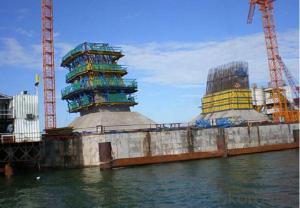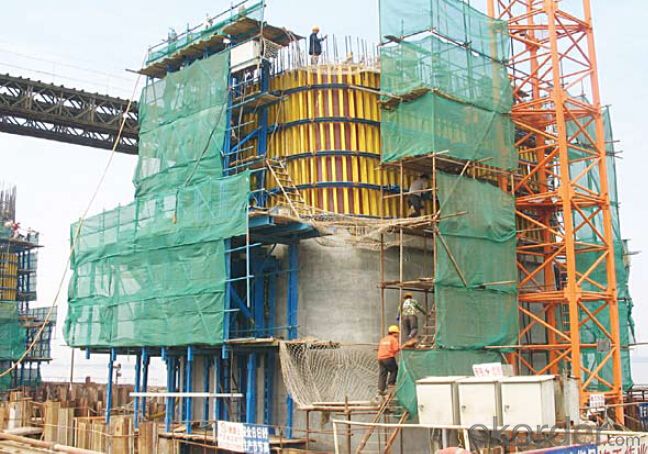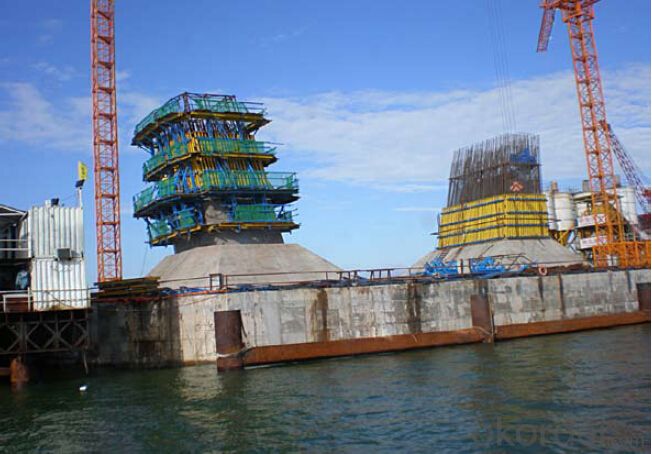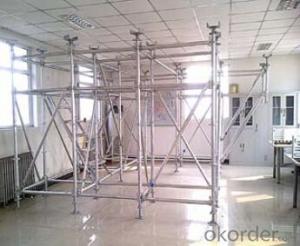Auto-Climbing bracket ACB 100 for formwork and scaffolding system
- Loading Port:
- Tianjin
- Payment Terms:
- TT OR LC
- Min Order Qty:
- 50 m²
- Supply Capability:
- 1000 m²/month
OKorder Service Pledge
OKorder Financial Service
You Might Also Like
Auto-climbing Bracket ACB100 & ACB50
The power of the auto-climbing formwork is the hydraulic system, which includes the oil cylinder
and two commutators. The commutators can control the climbing of climbing rail and the bracket.
The steel rail and the bracket can inter-climbing, so the whole system will climb up steadily.
Cranes are not needed during the construction. It’s easy to operate, highly efficient and safe. It’s
the best choice for the construction of high buildings and bridges.
There are mainly two types of standard auto-climbing brackets, ACB-50 and ACB-100, the figure
means the push power of cylinder with unit of KN.
Characteristics:
◆ Perfect load bearing anchor system
Anchor system is the most important supporting part. The system is made of five parts shown
below. Thereinto, tensile bolt, V-climbing cone and washer can be taken out for reusing after the
concrete pouring finished.There are two kinds of anchor systems,A & B. A is matched with single
anchor shoe and B is matched with double anchor shoe.
◆ Crane-independent
Crane-independent forming, striking and climbing speeds up the work procedures on the
construction site and also makes them independent of each other. This means the planned
sequences can be maintained along with guaranteeing high productivity levels. The crane can
therefore be used for other tasks.
Hydraulic system is mainly made of two commutators,
oil cylinder and power distribution system.The
commutators can control the climbing of climbing rail
and bracket.
◆ High bearing capacity and safe
The stable working platforms are able to carry large loads, e.g. the storage of reinforcing steel
for the next climbing section. Generously-sized working platforms, the well thought-out design for
handling very high wind loads and the patented control function of the climbing mechanism are
some of the special details contained within the comprehensive safety concept.
◆ Platforms adjusted to suit the angle of inclination
The horizontal working areas thus created provide safe and comfortable conditions for
reinforcement work, shuttering and striking, concreting and finishing.
◆ The ACB formwork system can climb not only vertically but also slantways, the largest angle is
18 degrees.
◆ The system can climb up wholly or separately. The climbing process is steady, synchronous
and safe.
◆ The bracket will not fall to the ground until the construction is finished, the field will be saved
and the impacting breakage will be reduced (especially the panel).
◆ The system will furnish omnidirectional platform, the construction organizations don’t need to
set up additional operation platform.
◆ The error of structure construction is small and easy to correct.
◆ The climbing speed is fast, the construction course will be quickened.
◆ The formwork can climb itself and cleaning work can be done in the same situs , the used times
of tower crane will be greatly reduced.
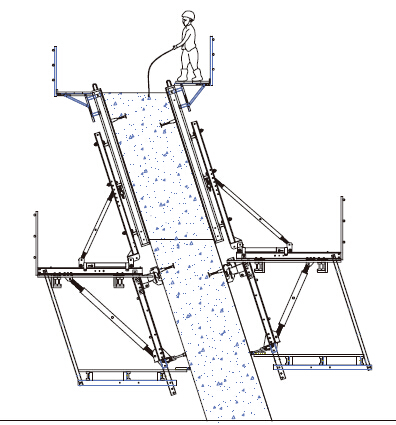
- Q: What are the different locking mechanisms used in steel formwork?
- There are several different locking mechanisms used in steel formwork to ensure stability and integrity during concrete construction projects. These mechanisms are designed to securely hold the formwork panels together and prevent any shifting or movement that may compromise the accuracy and quality of the final concrete structure. One commonly used locking mechanism is the wedge clamp system. This system consists of steel wedges that are inserted between the formwork panels and tightened using a hammer or mallet. The wedges create a strong connection between the panels, holding them tightly in place. Another popular locking mechanism is the pin and wedge system. This system involves the use of steel pins that are inserted through holes in the formwork panels. Then, steel wedges are driven into the holes, securing the pins in place. This creates a stable and secure connection between the panels. Some steel formwork systems also utilize a hook and loop mechanism. This involves the use of metal hooks that are attached to one panel and metal loops that are attached to the adjacent panel. The hooks and loops interlock, providing a strong connection between the panels. This mechanism is often quick and easy to use, making it a popular choice for certain construction projects. Additionally, some steel formwork systems use a combination of locking mechanisms. For example, a system may incorporate both wedge clamps and pin and wedge systems to provide extra stability and strength. Overall, the different locking mechanisms used in steel formwork serve the purpose of ensuring that the formwork panels remain securely connected throughout the concrete pouring process. Each mechanism has its advantages and may be more suitable for specific project requirements.
- Q: Can steel formwork be used in bridge construction projects?
- Yes, steel formwork can be used in bridge construction projects. Steel formwork refers to the temporary structure used to support and shape the concrete during the construction process. It is commonly used in various construction projects, including bridges. Steel formwork provides several advantages in bridge construction, such as high strength, durability, and resistance to deformation. It can withstand the weight of the concrete and other construction materials, ensuring the stability and integrity of the bridge structure. Additionally, steel formwork offers flexibility in creating complex bridge designs, allowing for the construction of different types of bridges, such as arch bridges, cable-stayed bridges, and suspension bridges. The use of steel formwork in bridge construction projects helps to streamline the construction process, improve efficiency, and ensure the quality of the final bridge structure.
- Q: Can steel formwork be used in areas with extreme temperature variations?
- Steel formwork is indeed capable of being utilized in regions with significant temperature fluctuations. Thanks to its high strength-to-weight ratio and resistance to thermal changes, steel is well-suited for diverse conditions. It can endure both high and low temperatures without experiencing structural deformity or deterioration. Moreover, steel formwork delivers exceptional stability and durability, guaranteeing its ability to withstand the strain caused by extreme temperature fluctuations. However, it is crucial to take into account the effects of thermal expansion and contraction when employing steel formwork in areas with substantial temperature variations, as these factors may influence the precision of the formwork and the ultimate concrete structure. By considering proper design aspects and employing appropriate installation techniques, any potential issues arising from temperature variations can be effectively managed.
- Q: What are the typical fire resistance ratings of steel formwork systems?
- Steel formwork systems can have varying fire resistance ratings due to factors like the type and thickness of the steel used, as well as the overall design and construction of the system. However, steel formwork systems are generally known for their high fire resistance properties. Steel, being a non-combustible material, does not contribute to the spread or intensity of fire. It has a high melting point and does not ignite or release flammable gases when exposed to fire. Consequently, steel formwork systems can withstand high temperatures and offer excellent fire resistance. Often, steel formwork systems are designed to meet or exceed specific fire resistance ratings set by building codes and regulations. These ratings are typically expressed in terms of time, such as 1 hour, 2 hours, or more, representing the duration for which the formwork system can maintain its structural integrity and protect against fire. To further enhance the fire resistance of steel formwork systems, additional measures like fire-resistant coatings or insulation materials can be incorporated. These measures provide an extra layer of protection, increasing the overall fire resistance of the formwork system. It's important to note that fire resistance ratings may also depend on other factors, such as the presence of fire-resistant materials in the surrounding structure and the implementation of overall fire safety measures in the building. Therefore, consulting with structural engineers, architects, and fire safety experts is crucial to determine the specific fire resistance requirements and ratings for steel formwork systems in a given construction project.
- Q: Are there any specific quality control measures for steel formwork construction?
- Yes, there are specific quality control measures for steel formwork construction. These measures are put in place to ensure that the steel formwork meets the required standards and specifications, and that it is safe and reliable for use in construction projects. One of the main quality control measures is the inspection of the steel formwork materials before they are used. This includes checking for any defects, such as cracks, rust, or other damage, that could affect the integrity and strength of the formwork. The materials should also be checked for proper dimensions and smoothness to ensure they fit together correctly and provide a smooth surface finish. Another quality control measure is the inspection of the steel formwork during and after the construction process. This involves checking that the formwork is properly assembled and secured, with all connections and joints correctly aligned and tightened. The formwork should also be inspected for any signs of deformation, such as bending or twisting, which could compromise its structural integrity. In addition to inspections, quality control measures also involve testing the steel formwork to assess its strength and durability. This can include conducting load tests to determine the maximum load capacity of the formwork, as well as tests to evaluate its resistance to environmental factors such as corrosion, fire, and moisture. Documentation and record-keeping are also important quality control measures for steel formwork construction. This includes maintaining detailed records of inspections, tests, and any repairs or modifications made to the formwork. This documentation ensures that the construction process is traceable and can be audited if necessary. Overall, these quality control measures for steel formwork construction are essential to ensure that the formwork is of high quality, meets the required standards, and provides a safe and reliable support system for concrete during construction.
- Q: What is the difference between the steel template and the assembled steel template?
- Why do you think I would like to set up a template for artificial labor costs higher than the stereotypes of the general template workers are square but the combination of the template construction is more difficult to be expensive so normal
- Q: How does steel formwork handle different concrete reinforcement spacing?
- Steel formwork is a versatile and robust solution that can easily handle different concrete reinforcement spacing. The formwork itself consists of steel panels or frames that are designed to be adjustable and flexible, allowing for customization according to the specific reinforcement spacing required for a particular concrete structure. Steel formwork panels have various features that make them suitable for accommodating different reinforcement spacing. These panels are typically available in different sizes and shapes, allowing for easy adjustment to fit the desired spacing. Additionally, the panels are usually equipped with adjustable clamps or connectors that enable them to be securely joined together, providing stability and support for the concrete. When it comes to concrete reinforcement spacing, steel formwork can be adapted to meet the specific requirements. The steel panels can be easily positioned and aligned to create the desired spacing for the reinforcement bars. This can be achieved by adjusting the panels horizontally or vertically to accommodate the required distance between the bars. Furthermore, steel formwork provides the necessary strength and durability to withstand the pressure exerted by the concrete during the pouring and curing process. This ensures that the formwork remains intact and stable, even when dealing with different reinforcement spacing. In conclusion, steel formwork is well-equipped to handle different concrete reinforcement spacing. Its adjustable and flexible design allows for customization to fit the specific requirements of each project. The strength and durability of steel formwork ensure that it can effectively support the concrete and maintain its stability throughout the construction process.
- Q: Can steel formwork be used for structures with complex geometries?
- Yes, steel formwork can be used for structures with complex geometries. Steel formwork is versatile and can be easily customized and adjusted to fit various shapes and sizes, making it suitable for constructing structures with intricate and complex designs. Its strength and durability also make it ideal for supporting and shaping concrete in challenging geometries.
- Q: How does steel formwork affect the overall timeline of a construction project?
- Steel formwork can significantly reduce the overall timeline of a construction project. Unlike traditional timber formwork, steel formwork is more durable and can be reused multiple times, resulting in faster assembly and disassembly. Its strength and rigidity allow for faster pouring and curing of concrete, reducing the time required for each construction phase. Additionally, steel formwork requires less maintenance and is less susceptible to warping or shrinking, ensuring a smooth and efficient construction process.
- Q: How does steel formwork affect the overall construction productivity?
- Steel formwork can significantly enhance overall construction productivity. It offers greater strength and durability compared to traditional formwork materials, allowing for faster and more efficient construction processes. Due to its reusable nature, steel formwork eliminates the need for constant replacement, reducing downtime and material costs. Additionally, its modular design enables easy assembly and disassembly, enabling faster construction cycles. The precision and accuracy of steel formwork also contribute to improved quality control, resulting in higher productivity and reduced rework.
Send your message to us
Auto-Climbing bracket ACB 100 for formwork and scaffolding system
- Loading Port:
- Tianjin
- Payment Terms:
- TT OR LC
- Min Order Qty:
- 50 m²
- Supply Capability:
- 1000 m²/month
OKorder Service Pledge
OKorder Financial Service
Similar products
Hot products
Hot Searches

